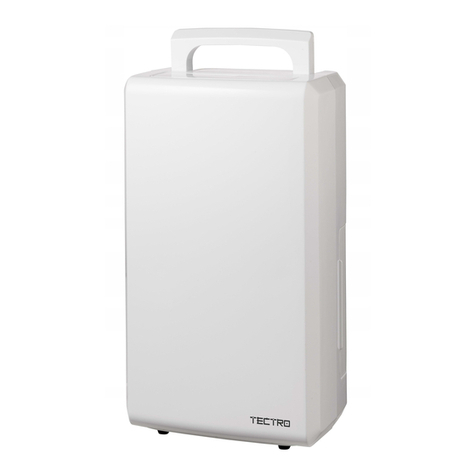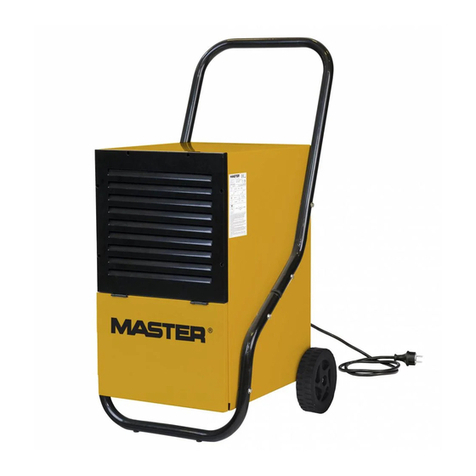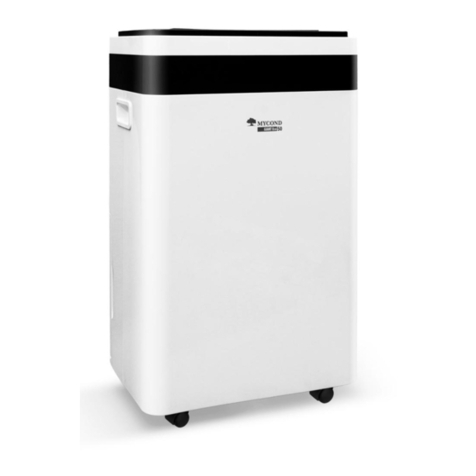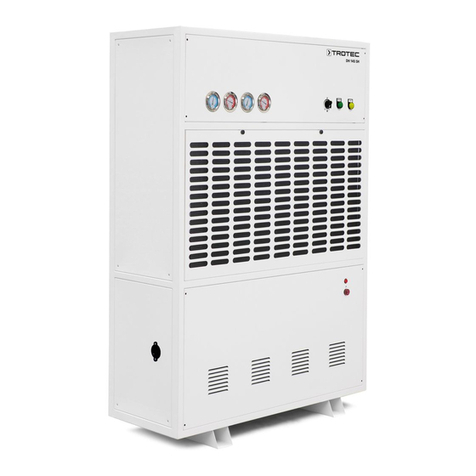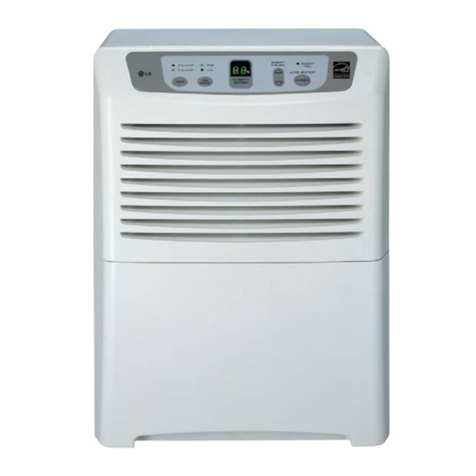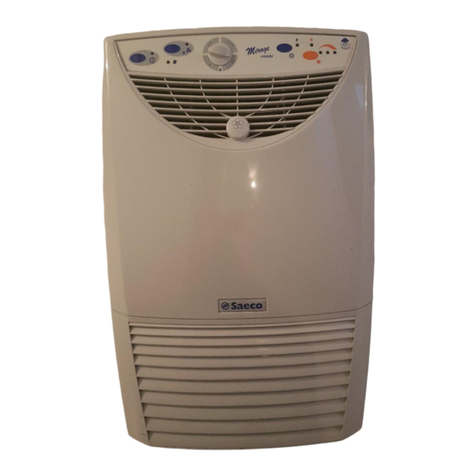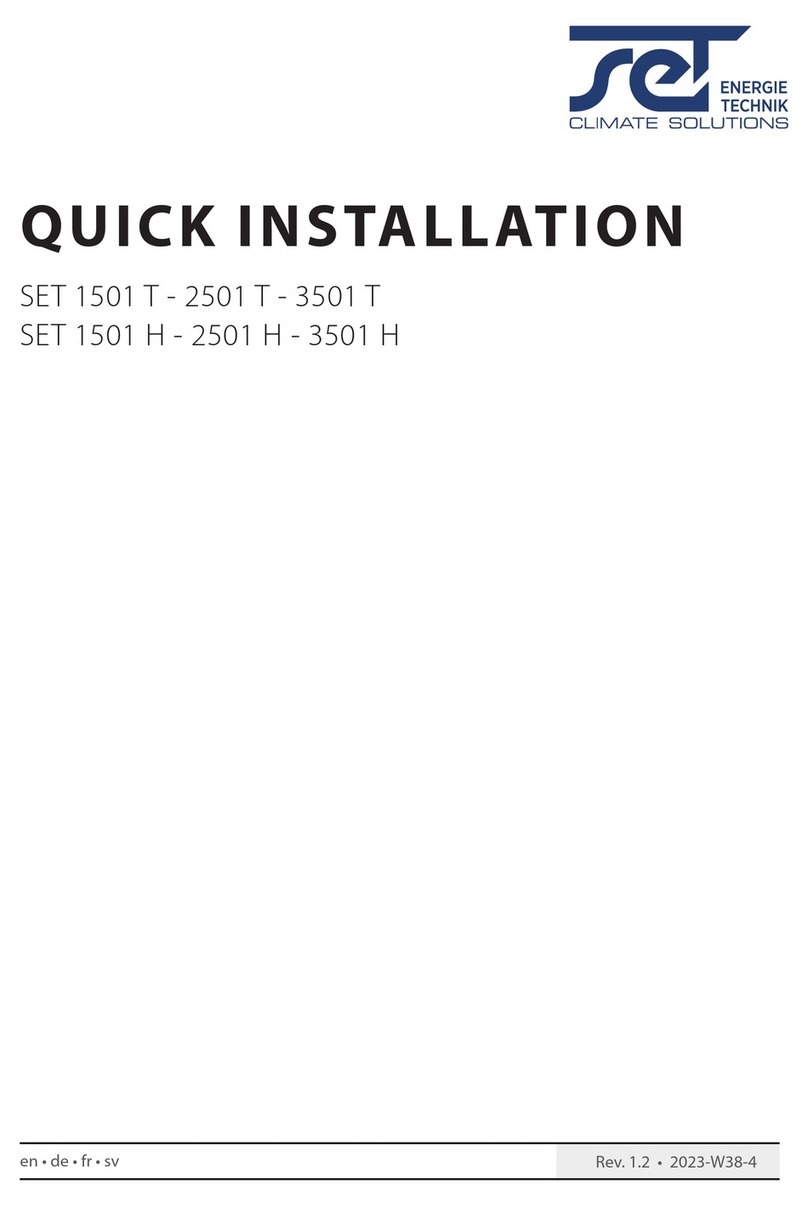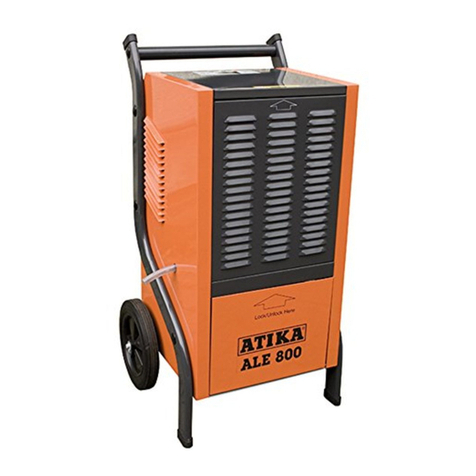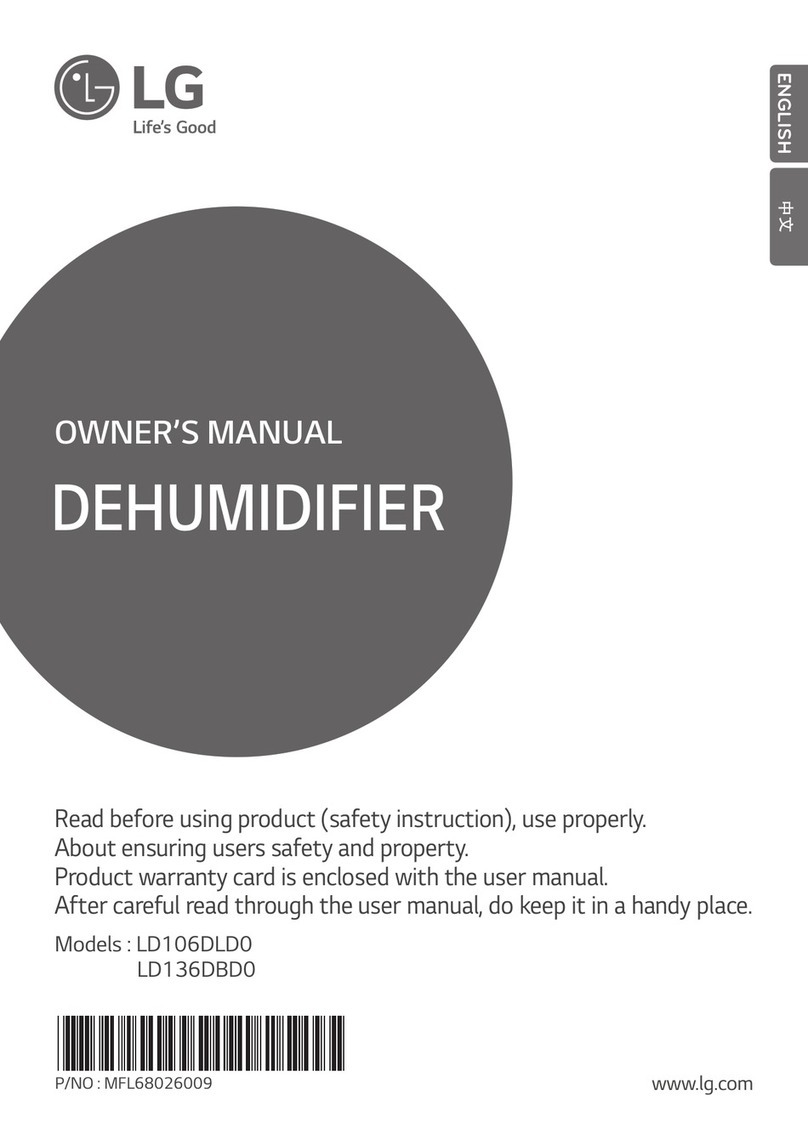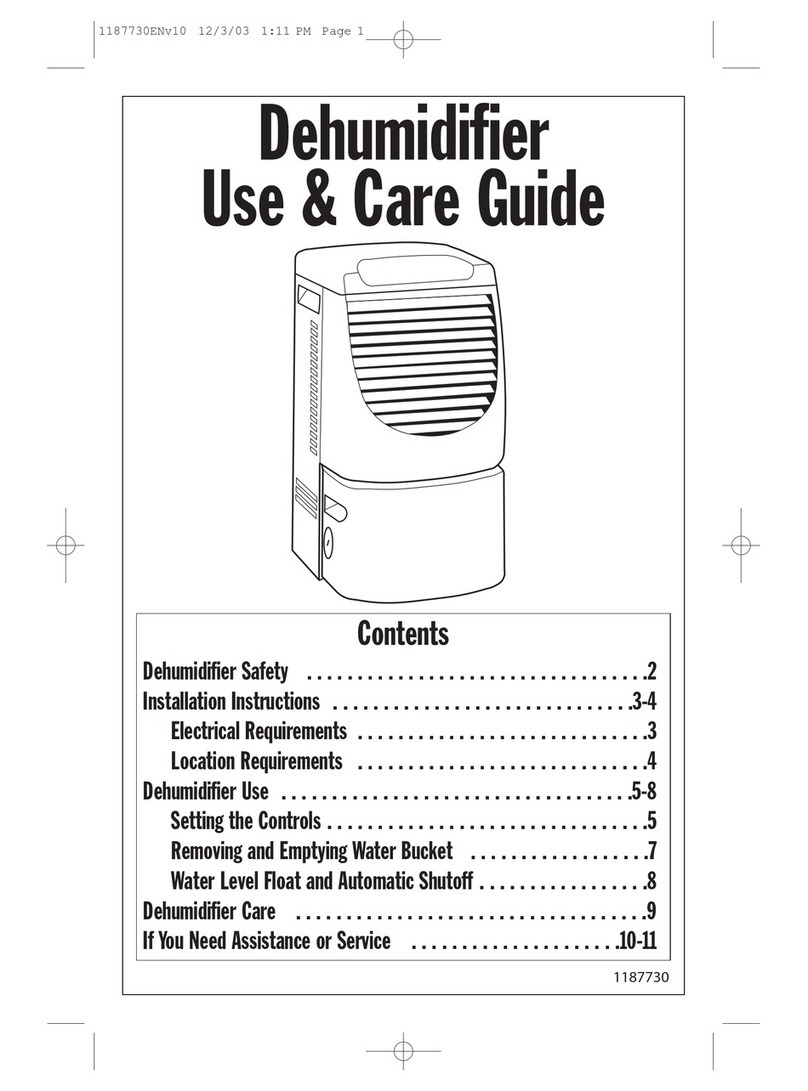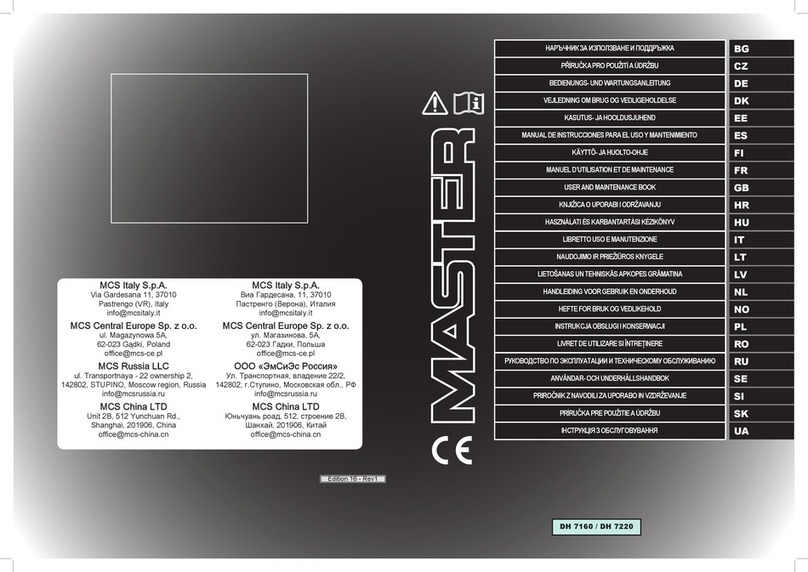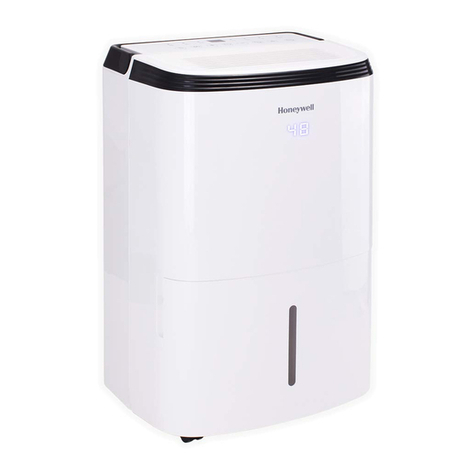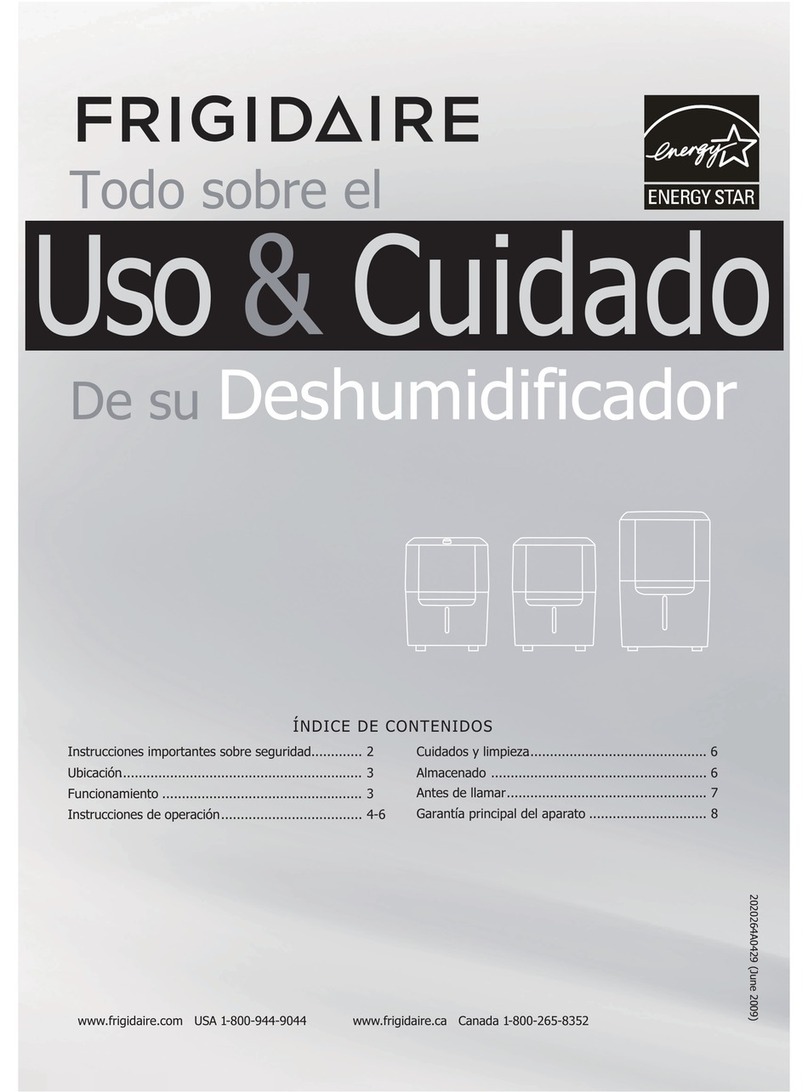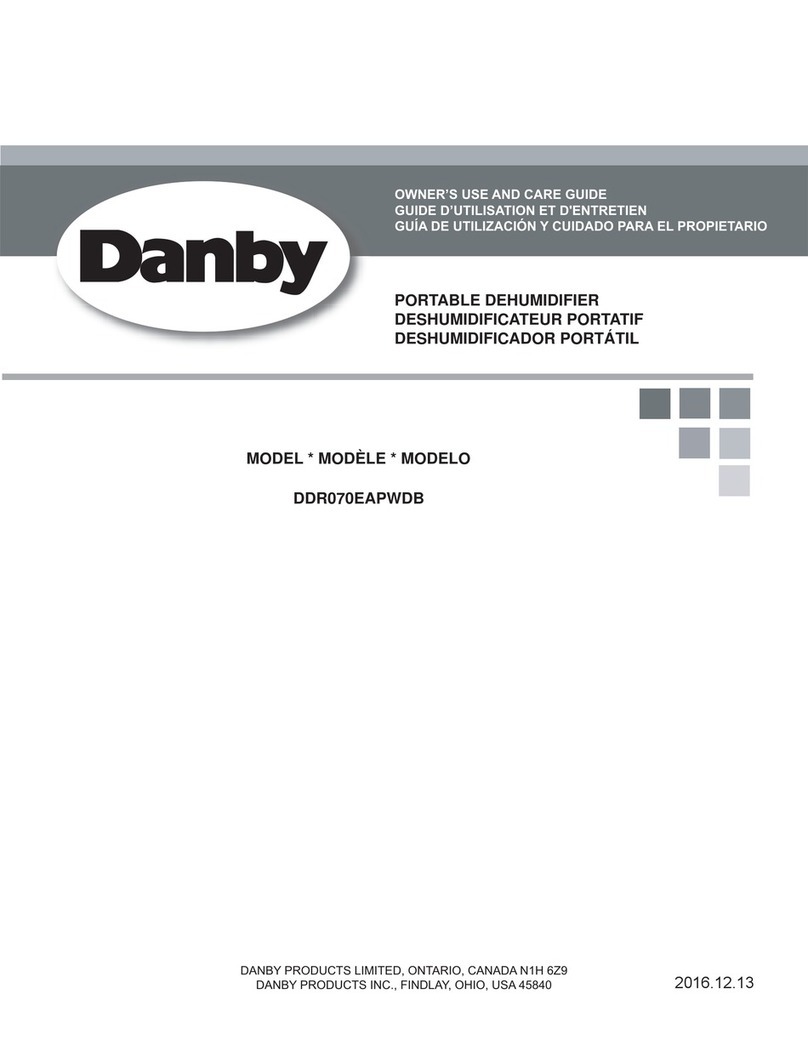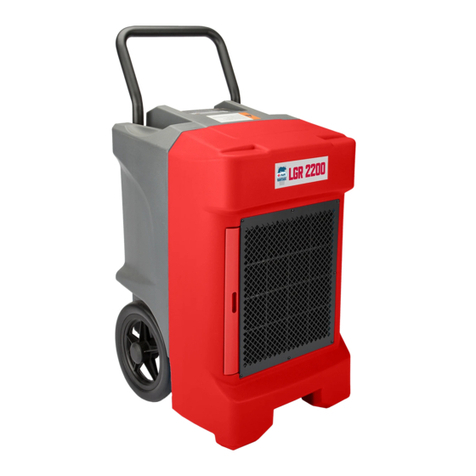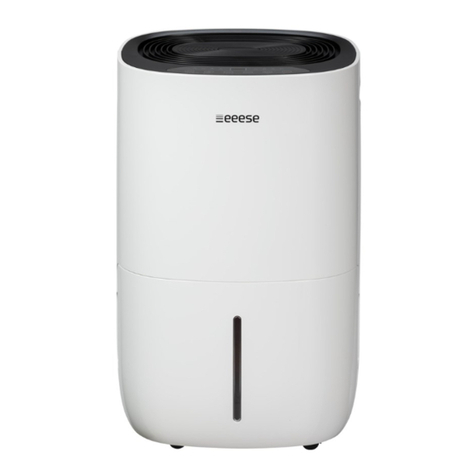HIdRos GH Series User manual

Original Instructions
DEHUMIDIFIERS FOR RADIANT COOLING SYSTEM
GH
SERIE
MTEC.4680.GB-B-1 Operation and maintenance manual GH serie English Rev. B 08-2017
Multiple instructions:
Consult the specific part
Read and understand
the instructions before
undertaking any work on
the unit
RETAIN FOR FUTURE REFERENCE
Incorporated in this document are the following:
• Declaration of conformity
• Technical manual
• Dimensional drawing
TECHNICAL MANUAL

Reproduction, data storage and transmission, even partial, of this publication, in any form, without the prior written authorisation of the Com-
pany, is prohibited. The Company can be contacted for all inquiries regarding the use of its products.
The Company follows a policy of continuous product development and improvement and reserves the right to modify specifications, equipment
and instructions regarding use and maintenance at any time, without notice.
Declaration of conformity
We declare under our own responsibility that the below equipment complies in all parts with the CEE and EN directives.
The declaration of conformity is enclosed to the technical booklet enclosed with the unit. The unit contains fluorinated greenhouse gases.

Rev. B 08-2017
3
MTEC.4680.GB-B-1 Operation and maintenance manual GH serie English
GH Dehumidifiers for radiant cooling system
INDICE
1. INTRODUCTION................................................................................................................................................................................... 5
1.1 Preliminary information.................................................................................................................................................... 5
1.2 Aim and content of the manual ........................................................................................................................................ 5
1.3 How to store this manual ................................................................................................................................................. 5
1.4 Manual updates ............................................................................................................................................................... 5
1.5 How to use this manual ................................................................................................................................................... 5
1.6 Potential risks .................................................................................................................................................................. 6
1.7 General description of symbols used............................................................................................................................... 7
1.8 Safety symbols used........................................................................................................................................................ 8
1.9 Limitations and prohibited use......................................................................................................................................... 9
1.10 Unit identification ........................................................................................................................................................... 9
2. SAFETY ............................................................................................................................................................................................. 10
2.1 Warning re potentially hazardous toxic substances....................................................................................................... 10
2.2 Refrigerant handling ...................................................................................................................................................... 10
2.3 Prevention of inhalation of high vapor concentrations................................................................................................... 11
2.4 Procedures in the event of accidental release of refrigerant ......................................................................................... 11
2.5 Main Toxicological information on the type of refrigerant used...................................................................................... 11
2.6 First aid measures ......................................................................................................................................................... 11
3. TECNICHAL CHARACTERISTICS ..................................................................................................................................................... 12
3.1 Unit description.............................................................................................................................................................. 12
3.2 Accessories.................................................................................................................................................................... 14
3.3 Unit components............................................................................................................................................................ 15
3.5 Refrigerant circuit layout................................................................................................................................................ 15
3.6 Technical data................................................................................................................................................................ 17
3.7 Hydraulic circuit pressure drops ....................................................................................................................................18
3.8 Operation limits.............................................................................................................................................................. 19
3.9 Sound data .................................................................................................................................................................... 19
3.10 Safety devices ............................................................................................................................................................. 20
3.11 Electric data ................................................................................................................................................................. 20
4. INSTALLATION ................................................................................................................................................................................... 20
4.1 General safety guidelines and and use of symbols ....................................................................................................... 20
4.2. Health and safety Considerations................................................................................................................................. 21
4.3 Personal protective equipment ...................................................................................................................................... 21
4.4 Inspection ...................................................................................................................................................................... 22
4.5 Storage .......................................................................................................................................................................... 22
4.6 Unpacking...................................................................................................................................................................... 22
4.7 Lifting and handling........................................................................................................................................................ 23
4.8 Location and minimum technical clearances................................................................................................................. 23
4.9 Condensate draining connections ................................................................................................................................. 24
4.10 Water coil hydraulic connection ................................................................................................................................... 24
4.11 How to vent the unit ..................................................................................................................................................... 24
4.12 Ductwork unit connection............................................................................................................................................. 25
4.13 Standard version: Remote mechanical hygrostat connection (HYGR.20)................................................................... 27
4.14 WZ version : Remote mechanical hygrostat connection (HYGR.30)........................................................................... 27
4.15 Filter extraction ............................................................................................................................................................ 28
4.16 Electric connections: preliminary safety information.................................................................................................... 29
4.17 Electrical data .............................................................................................................................................................. 29
4.18 Electrical connections.................................................................................................................................................. 30
5. UNIT START UP.................................................................................................................................................................................. 32
5.1 Preliminary checks......................................................................................................................................................... 32
5.2 Control panel ................................................................................................................................................................. 32
6. USE ..................................................................................................................................................................................................... 33
6.1 Unit switch on and first start up...................................................................................................................................... 33
6.2 Stop ............................................................................................................................................................................... 33
6.3 Stand-by ........................................................................................................................................................................ 33

Rev. B 08-2017
4
MTEC.4680.GB-B-1 Operation and maintenance manual GH serie English
GH Dehumidifiers for radiant cooling system
6.4 Displaying during an alarm ............................................................................................................................................ 33
7. MAINTENANCE OF THE UNIT...........................................................................................................................................................45
7.1 General warnings........................................................................................................................................................... 45
7.2 Drive access .................................................................................................................................................................. 45
7.3 Periodical checks........................................................................................................................................................... 45
7.4 Refrigerant circuit repair ................................................................................................................................................46
8. DECOMMISSIONING.......................................................................................................................................................................... 47
8.1 Disconnect the unit ........................................................................................................................................................ 47
8.2 Disposal, recovery and recycling................................................................................................................................... 47
8.3 RAEE Directive (only UE).............................................................................................................................................. 47
9. DIAGNOSIS AND TROUBLESHOOTING .......................................................................................................................................... 48
9.1 Fault finding .................................................................................................................................................................. 48
10.DIMENSIONAL DRAWINGS .............................................................................................................................................................. 49

Rev. B 08-2017
5
MTEC.4680.GB-B-1 Operation and maintenance manual GH serie English
GH Dehumidifiers for radiant cooling system
1. INTRODUCTION
1.1 Preliminary information
1.2Aim and content of the manual
1.3 How to store this manual
1.4 Manual Update
1.5 How to use this manual
Reproduction, storage or transmission of any part of this publication in any form, without the prior written consent of the Company, is pro-
hibited.
The unit to which these instructions refer, is designed to be used for the the purposes described and to be operated in accordance with
these instructions.
The Company will not be liable for claims for damage caused to persons, animals, material goods or property caused by improper installa-
tion, adjustment and maintenance or improper use. Any use not specified in this manual is prohibited.
This document is intended to provide information only and does not form a contract with third parties.
The Company pursues a policy of constant improvement and development of its products and therefore reserves the right to change the
specifications and the documentation at any time, without notice and without obligation to update existing equipment.
These instructions are intended to provide the information required for the selection, installation, use and maintenance of the unit.
They have been prepared in accordance with the European Union laws and with the technical standards in force at the date of issue of the
instructions.
The instructions contain all the necessary information to prevent any reasonably foreseeable misuse.
The manual must be kept in a suitable place with easy access for users and operators, protected from dust and damp.
The manual must always accompany the unit during the entire life cycle of the same and therefore must be transferred to any subsequent
user.
It is recommended that the manual is updated to the latest revision available.
If updates are sent to the customer they must be added to this manual.
The latest information regarding the use of its products is available by contacting the Company.
The manual is an integral part of the unit.
Users or operators must consult the manual before performing any operation and especially so when transporting, han-
dling, installating, maintaining, or dismantling the unit in order to eliminate uncertainty and reduce risk.
In these instructions symbols have been used (described in the following paragraphs) to draw the attention of operators
and users to the operations that have a higher risk and which must be performed safely.

Rev. B 08-2017
6
MTEC.4680.GB-B-1 Operation and maintenance manual GH serie English
GH Dehumidifiers for radiant cooling system
1.6 Potential Risks
Whilst the unit has been designed to minimize any risk posed to the safety of people who will interact with it, it has not been technically
possible to eliminate completely the causes of risk. It is therefore necessary to refer to the requirements and symbolism below:
LOCATION OF
RISK POTENTIAL RISK METHOD OF INJURY PRECAUTIONS
Thermal heat
exchangers. Small stab wounds. Contact Avoid any contact,
use protective gloves.
Fan and fan grilles. Cuts, eye damage,
broken bones.
Insertion of sharp objects
through the grid while the fans
are operating.
Never put objects through the pro-
tection grilles.
Internal component:
compressors and
discharge pipes
Burns. Contact Avoid any contact, use protective
gloves.
Internal component:
electric cables and
metallic parts
Electrocution,
severe burns.
Defect in the supply cable in-
sulation, live metallic parts.
Adequate protection of power ca-
bles, ensure correct earthing of all
metal parts.
External to unit:
unit enclosure
Poisoning,
severe burns.
Fire due to short circuit or
overheating of the supply ca-
ble external to unit.
Size cables and mains protection
system in accordance with iee regu-
lations.
Low pressure safety
valve.
Poisoning,
severe burns.
High evaporating pressure
causing a refgrigerant dis-
charge during maintenance.
Carefully check the evaporating
pressure during the maintenance
operations.
High pressure safety
valve.
Poisoning,
severe burns,
hearing loss.
Activation of the high pressure
safety valve with the refriger-
ant circuit open.
If possible, do not open the refrig-
erant circuit valve; carefuly check
the condensing pressure; use all
the personal protective equipment
required by law.
Entire unit External fire
Fire due to natural disasters
or combustions of elements
nearby unit
Provide the necessary fire-fighting
equipment
Entire unit
Explosion, injuries, burns, poi-
soning, folgoramento for natural
disasters or earthquake.
Breakages, failures due to natu-
ral disasters or earthquake
Plan the necessary precautions both
electrical (suitable differential ma-
gneto and electrical protection of the
supply lines; greatest care during the
connections of the metal parts), and
mechanical (special anchors or sei-
smic vibrations to prevent breakages
or accidental falls ).

Rev. B 08-2017
7
MTEC.4680.GB-B-1 Operation and maintenance manual GH serie English
GH Dehumidifiers for radiant cooling system
BANNED
A black symbol inside a red circle with a red diagonal indicates an action that should not be performed.
WARNING
A black graphic symbol added to a yellow triangle with black edges indicates danger.
ACTION REQUIRED
A white symbol inserted in a blue circle indicates an action that must be done to avoid a risk.
The graphic symbol “warning” is qualified with additional safety information (text or other symbols).
Safety symbols combined in accordance with ISO 3864-2:
1.7 General Description of Symbols Used
Safety symbols combined in accordance with ISO 3864-2:

Rev. B 08-2017
8
MTEC.4680.GB-B-1 Operation and maintenance manual GH serie English
GH Dehumidifiers for radiant cooling system
GENERAL RISK
Observe all signs placed next to the pictogram. The failure to follow directions may create a risk situation that may
be injurious to the user.
ELECTRICAL HAZARD
Observe all signs placed next to the pictogram.
The symbol indicates components of the unit and actions described in this manual that could create an electrical
hazard.
MOVING PARTS
The symbol indicates those moving parts of the unit that could create risk.
HOT SURFACES
The symbol indicates those components with high surface temperature that could create risks.
SHARP SURFACES
The symbol indicates components or parts that could cause stab wounds.
EARTH CONNECTION
The symbol identifies Earthing connection points in the unit.
READAND UNDERSTAND THE INSTRUCTIONS
Read and understand the instructions of the machine before any operations.
RECOVER OR RECYCLE MATERIAL
1.8 Safety symbols used
The unit is not suitable for operations in environments:
• excessively dusty or potentially explosive atmospheres;
• where there are vibrations;
• where there are electromagnetic fields;
• where there are aggressive atmospheres
The machine is designed and built exclusively for the uses described in “Limitations of use” of the technical manual.
Any other use is prohibited because it may pose a potential risk to the health of operators and users.
1.9 Limitations and prohibited use

Rev. B 08-2017
9
Manufacturer: PD322111
Contiene gas fluorurati ad effetto serra disciplinati dal protocollo di Kyoto
Contains fluorinated greenhouse gasses covered by the Kyoto protocol
Modello
Model
1GH0.025A-2E 123456
2 8/2017
R134A
0,25 Kg 0,36 ton
2 1430
230V-1ph-50Hz
10 bar 20,6 bar
-30 °C
45 Kg
+130 °C -30 °C +130 °C
2,80 A 0,50 kW
Matricola
Serial number
Categoria PED
PED Category
Tipo refrigerante
Refrigerant type
Tensione-Fasi-Frequenza
Voltage-Phases-Frequency
LATO BASSA PRESSIONE
LOW PRESSURE SIDE
LATO ALTA PRESSIONE
HIGH PRESSURE SIDE
Gruppo fluido
Fluid group GWP
Carica refrigerante
Refrigerant charge
C1
C3
C2
Min Max Min Max
C4
F.L.A. (A) F.L.I. (kW)
PS
Temperatura di progetto
Design temperature
Peso a vuoto
Weight
Temperatura di progetto
Design temperature
CO2Equivalente
CO2Equivalente
Data di fabbricazione
Manifacture date
PS
LE
AC SIMILE
FAC
FAC
SI
SI
MIL
F
0,36 ton
10 ba
2,8
enza
uency
SSA PRESSIONE
SSURE SIDE
O
2
Equivalente
CO
2
Equivale
Via E. Mattei, 20
35028 Piove di Sacco (Pd)
Italy
MTEC.4680.GB-B-1 Operation and maintenance manual GH serie English
GH Dehumidifiers for radiant cooling system
1.10 Unit identification
Each unit has a rating plate that provides key information regarding the machine.
The rating plate may differ from the one shown below as the example is for a standard unit without accessories.
For all electrical information not provided on the label, refer to the wiring diagram.
A facsimile of the label is shown below:
The product label should never be removed from the unit.

Rev. B 08-2017
10
MTEC.4680.GB-B-1 Operation and maintenance manual GH serie English
GH Dehumidifiers for radiant cooling system
R407C
HFC TWA 1000 ppm
HFC125 TWA 1000 ppm
HFC134a TWA 1000 ppm - 4240 mg/m3 (OES)
R134A
HFC-134a TWA 1000 ppm
2.1.1 Identification of the Type of Refrigerant Fluid Used: R407C:
Difluoromethane (HFC32) 23% by weight CAS No.: 000075-10-5•
Pentafluoroethane (HFC125) 25% in peso CAS No.: 000354-33-6•
• 1,1,1,2 – Tetrafluoroethane (HFC134a) 52% by weight CAS No.: 000811-97-2
R134a: Tetrafluoroethane (HFC134a) 100% by weight CAS No.: 000811-97-2
2.1 Warning re potentially hazardous toxic substances
2. SAFETY
For further information regarding the characteristics of the refrigerant and oil used, refer to the safety data sheets
available from the refrigerant and oil manufacturers.
2.1.2 Identification of the Type of Oil Used.
The lubricant used is polyester oil. Please refer to the information provided on the compressor data plate.
ENVIRONMENTAL PROTECTION : Read the ecological information and the following instructions carefully.
Main Ecological Information Regarding the Types of refrigerants Fluids used.
2.1.3 Persistence and degradation
The refrigerants used decompose in the lower atmosphere (troposphere) relatively quickly. The decomposed products are highly dispersible
and therefore have a very low concentration. They do not influence the photochemical smog which is not among the VOC volatile organic
compounds (as stipulated in the guidelines to the UNECE). The constituent refrigerants of R407C (R32, R125 and R134a), do not damage
the ozone layer. These substances are regulated under the Montreal Protocol (revised 1992) and regulations EC no. 2037/200 of 29 June
2000.
2.1.4 Effects of discharges
2.1.5 Exposure controls and personal protection
Discharges into the atmosphere of this product does not cause a long-term contamination.
Wear protective clothing and gloves, protect your eyes and face
2.1.6 Professional exposure limits
2.2 Refrigerant handling
Users and maintenance personnel must be adequately informed about the possible risks of handling potentially
toxic substances. Failure to follow such instructions can cause damage to personnel or to the unit.

Rev. B 08-2017
11
MTEC.4680.GB-B-1 Operation and maintenance manual GH serie English
GH Dehumidifiers for radiant cooling system
2.3 Prevent inhalation of high vapor concentration
2.4 Procedures to be adopted in the event of accidental release of refrigerant
Atmospheric concentrations of refrigerant must be minimized and kept to a level that is below the occupational exposure limit. Vapor is
heavier than air and can form dangerous concentrations near the ground where the ventilation rate is lower. Always ensure adequate venti-
lation. Avoid contact with open flames and hot surfaces as this can cause toxic and irritating decomposition products to form. Avoid contact
between liquid refrigerant and the eyes or skin.
Ensure suitable personal protection (especially respiratory protection) during cleaning operations.
If deemed safe, isolate the source of the leak. If the leakage is small and if adequate ventilation is provided, allow the refrigerant to evapo-
rate. If the loss is substantial ensure that measures are taken to adequately ventilate the area.
Contain spilled material with sand, earth or other suitable absorbent material.
Do not allow the refrigerant to enter drains, sewers or basements, as pockets of vapor can form.
2.5 Main Toxicological Information Regarding the Type of refrigerant used
2.6 FirstAid Measures
2.6.1 Inhalation
2.6.2 Contact with skin
Move the person away from the source of exposure, keep him/her warm and let him/her rest. Administer oxygen if necessary. Attempt
artificial respiration if breathing has stopped or shows sings of stopping. If the heart stops, perform external heart massage. Seek medical
assistance.
In case of contact with skin, wash immediately with lukewarm water. Thaw tissue using water. Remove contaminated clothing. Clothing may
stick to the skin in case of frostbite. If irritation, swelling or blisters appear, seek medical assistance.
Adhere scrupulously to the warnings and first aid procedures indicated below.
2.5.1 Inhalation
A high atmospheric concentration can cause anaesthetic effects with possible loss of consciousness. Prolonged exposure may lead to
irregular heartbeat and cause sudden death. Higher concentrations may cause asphyxia due to the reduced oxygen content in the atmo-
sphere.
2.5.2 Contact with skin
Splashes of nebulous liquid can produce frostbite. Probably not hazardous if absorbed trough the skin. Repeated or prolonged contact may
remove the skin’s natural oils, with consequent dryness, cracking and dermatitis.
2.5.3 Contact with eyes
Splashes of liquid may cause frostbite.
2.5.4 Ingestion
While highly improbable, may produce frostbite.
2.6.3 Contact with eyes
Rinse immediately using an eyewash or clean water, keeping eyelids open, for at least ten minutes. Seek medical assistance.
2.6.4 Ingestion
Do not induce vomiting. If the injured person is conscious, rinse his/her mouth with water and make him/her drink 200-300ml of water. Seek
immediate medical assistance.

Rev. B 08-2017
12
MTEC.4680.GB-B-1 Operation and maintenance manual GH serie English
GH Dehumidifiers for radiant cooling system
3. TECHNICAL CHARACTERISTICS
3.1 Unit description
The dehumidifiers are high performance units, equipped with robust galvanised steel frame, properly designed to operate in combination
with radiant cooling systems.
The units are suitable for false ceiling applications and ductable too.
The full range of dehumidifier have pre and post cooling coil able to grant high level of air temperature control.
The units, can operate even without pre and post cooling coils, this option could be very useful in middle seasons when it is necessary to
dry but the air conditioning system is not in operation.
All units are fully in compliance with the European norms and provided with CE marks and dedicated conformity certificate.
3.1.1 Frame
All units are made from hot-galvanised thick sheet metal, to ensure the best resistance against the corrosions.
The cabinet frame is made by removable panels to allow an easy inspection and internal maintenance.
The condensing drip tray is supply as standrad in all models. It is made in plastic material for model 25 and galvanized metal sheet for
model 50-100-200.
3.1.2 Refrigerant Circuit
The refrigerant circuit is made by using international primary brands components and according to ISO 97/23 concerning welding pro-
cedures. The refrigerant gas used in these units is R134a for the model 25 and R407C for the models 50-100-200.The refrigerant circuit
includes: filter drier, capillary expansion device, Schrader valves for maintenance and control, pressure safety device (according to PED
regulation).
3.1.3 Compressor
The compressor is reciprocating type (mod. 25) and rotative type for all other models, equipped with crankcase heater and thermal overload
protection by a klixon embedded in the motor winding. It’s mounted on rubber vibration dampers and, by request, it can be supplied with
some jackets to reduce the noise (accessory).
3.1.4 Condensers and Evaporators
The condensers and evaporators are made of copper pipes and aluminium fins. The diameter of the copper pipes is 3/8” and the thickness
of the aluminium fins is 0,1 mm.The tubes are mechanically expanded into the aluminium fins to improve the heat exchange factor. The ge-
ometry of these condensers guarantees a low air side pressure drop and then the use of low rotation (and low noise emission) fans. All the
units have a stainless steel drip tray. All WZ units configuration, in addition to these exchanger, use a third brazed plate heat exchanger
made of stainless steel AISI 316 as condenser in cooling mode.
3.1.5 Pre and post cold water coils
The pre and post cold water coils are made of copper pipes and aluminium fins. The diameter of the copper pipes is 3/8” and the thickness
of the aluminium fins is 0,1 mm. The tubes are mechanically expanded into the aluminium fins to improve the heat exchange factor. The pre-
cooling coil is used to increase the dehumidification capacity of the unit, while the post-cooling coil is used to keep the outlet air temperature
at the same inlet value. In WZ version the pre-treatment coil only is present.
3.1.6 Water condenser (only for WZ version)
Type-brazed plate, made of stainless steel AISI 316; The water condenser is used in the summer season as cooling integration.
3.1.7 Supply fan
The supply fan is centrifugal type, double inlet with forwards blades, dynamically and statically balanced and directly connected to a 3 speed
fan motor. Installed into the unit by interposed ant-vibration kit.
3.1.8Air Filter
For the model 50 it’s supplied standard with the unit and it’s built in nylon. It can be removed for differential disposal, class G2, according to
EN 779:2002. Regarding the model 100-200 instead, it’s made of filtering material in synthetic fibre without electrostatic charge. It can be
2.6.5 Further medical treatment
Treat symptoms and carry out support therapy as indicated. Do not administer adrenaline or similar sympathomimetic drugs following
exposure, due to the risk of cardiac arrhythmia.

Rev. B 08-2017
13
MTEC.4680.GB-B-1 Operation and maintenance manual GH serie English
GH Dehumidifiers for radiant cooling system
removed for differential disposal, class G3, according to EN 779:2002.
3.1.9 Microprocessor
All units are equipped with a microprocessor for controlling the timing of the compressor, defrosting cycles and alarms. A special card with
light signals indicates the presence of the supply voltage, the activation of defrosting cycle or the presence of an alarm.
3.1.10 Electric box
The electric switch board is made according to electromagnetic compatibility norms CEE 73/23 and 89/336. The accessibility to the board
is possible after removing the front panel of the unit. Ready for the connection to the power and to the consensus control, The terminal
board is also supplied with voltage free contacts for remote ON-OFF. The terminal block is also arranged with two (2) free contacts to allow
operation in ventilation mode only (the 1st) in cooling mode operation (version WZ) the 2nd. Closing the first contact, it will be enabled for
operation in fan only while the dehumidification function will be disabled.
3.1.11 Control and protection devices
All units are supplied with the following control and protection devices: defrost thermostat, who signals to the microprocessor control that a
defrost cycle is needed and controls its termination (only for models 100-100W and 200-200W). Water temperature sensor, that signals to
the microprocessor the eventual overcome of the hot water temperature set point in the pre and post water coils during winter operation. In
this condition the compressor is disconnected while the fan always run and, when the water temperature returns within the operation limits,
restarts the compressor. The water sensor stops the compressor when the water temperature is above 35°C. The eventual use of of the
dehumidifier as heating device during winter season requires an additional remote thermostat with seasonal change over (not supplied).
3.1.12 Test
All the units are fully assembled and wired at the factory, carefully evacuated and dried after leak tests under pressure and then charged
with ecologic refrigerant. They are all fully operational tested before shipment. They all conform to European Directives and are individually
marked with the CE label and provided with Conformity Declaration.
3.2 Versions
3.2.1 WZ
Units supplied with double condenser (the first is an air condenser, the second is a water one) and of a logic which allows the dehumidifi-
cation with neutrum air or with cooled air.
3.3Accessories
3.3.1 Remote mechanical hygrostat (HYGR.20) (for standard versions only)
To be installed on the wall, it is supplied with a regulation knob and working range from 30% to 100% with precision of 3%.
3.3.2 Remote mechanical hygrostat (HYGR.30) (for WZversion only)
To be installed on the wall, it is supplied with a regulation knob and working range from 30% to 100%.
Temperature working range from 10°C to 35 °C with precision of 3%.

Rev. B 08-2017
14
1
2
3
4
5
6
7
8
9
12345
6
9
7
8
10
16
27
38
49
510
MTEC.4680.GB-B-1 Operation and maintenance manual GH serie English
GH Dehumidifiers for radiant cooling system
3.4 Unit components
3.4.1 Unit components standard version
3.4.2 Unit components WZ version
Air filter Compressor
Pre-cooling coil Electronic card
Evaporator Fan
Condenser Bracket
Condensing drain Condenser water

Rev. B 08-2017
15
12
35
4
89
7
6
MTEC.4680.GB-B-1 Operation and maintenance manual GH serie English
GH Dehumidifiers for radiant cooling system
3.5 Refrigerant circuit layout
3.5.1 Refrigerant circuit standard version
The functioning of the dehumidifier is as follows: the fan takes the air from the ambient (7) and it’s made go through the filter (1) and the
pre-cooling water coil (2) where it’s cooled and brought to a condition closed to saturation. Now it passes through the evaporating coil (3)
where it’s fatherly cooled and dehumidified. The air passes now through the condensing coil (5) where it’s post heated (with a constant
humidity) and in the postcooling coil (6) where it’s reported to the required conditions.
All the dehumidifiers can work without the help of the pre and post cooling coils. This function is very useful in
case there is the request of dehumidification in middle-season or when the chiller is off. Obviously, if the unit works
without the help of the cold water, the air in outlet will be hotter than the air in inlet.

Rev. B 08-2017
16
12
35
4
89
7
10
MTEC.4680.GB-B-1 Operation and maintenance manual GH serie English
GH Dehumidifiers for radiant cooling system
3.5.2 Refrigerant circuit layout WZ version
The operation of the dehumidifier is as follows: the fan takes the air from the ambient (7) and it’s made go through the filter (1) and the pre-
cooling water coil (2) where it’s cooled and brought to a condition closed to saturation. Now it passes through the evaporating coil (3) where
it’s fatherly cooled and dehumidified. At this point there are two possible modalities:
• Modality with neutrum air: The air passes now through the condensing coil (5) which allows to condensate the 50% of the total gas, (the
unit condensate the 50% on air with the heat exchanger (5) and the 50% in water with the heat exchanger (10)) then there is the post-
heating so that to avoid to send air in the ambient in neutrum thermic conditions.
• Modality with cooled air:The unit condensates the 100% in water through the heat –exchanger (10). The air, then, go through the conden-
ser (5) (disabled) where does not change its characteristics (temperature and humidity).
• Dehumidification with Air Heated mode: The unit in this case performs 100% of the condensation in the air with the heat exchanger (5)
then the air at the evaporator outlet (3) passes through the condenser (5) that heats the air at constant humidity and then, the air that will
be injected into the room has the same moisture that has output from the heat exchanger (3) but at a higher temperature.
WZ versions can work with air dehumidification mode with cold air only if feed by the water plant (normally
around 15 ÷ 18°C). In the absence of cold water, the units must be switched manually in winter mode, to operate
in dehumidification + heating.

Rev. B 08-2017
17
25 50 100 200
R134a R407C R407C R407C
Kg 0,25 0,7 1,0 1,7
1430 1774 1774 1774
t 0,36 1,24 1,77 3,02
l/24h 20,1 48,5 87,2 164
V/Ph/Hz 230/1/50 230/1/50 230/1/50 230/1/50
W --- --- --- ---
W 340 700 1450 2450
A 2,5 4,6 7 13,5
W 450 800 1600 2950
A 2,8 4,9 8,8 15
l/h 150 500 600 900
kPa 8 17 32 48
l/h --- --- --- ---
kPa --- --- --- ---
m3/h 250 600 1000 1850
Pa 43 60 75 120
dB(A)45505764
dB(A)37424956
25WZ 50WZ 100WZ 200WZ
R134a R407C R407C R407C
Kg 0,62 0,9 1.6 2,0
1430 1774 1774 1774
t 0,89 1,57 2,79 3,55
l/24h 20,1 48,5 87,2 164
V/Ph/Hz 230/1/50 230/1/50 230/1/50 230/1/50
W 1250 3500 6000 11300
W 340 700 1450 2450
A 2,5 4,6 7 13,5
W 450 800 1600 2950
A 2,8 4,9 8,8 15
l/h --- --- --- ---
kPa --- --- --- ---
l/h 150 500 600 900
kPa 7,8 22 39,5 64
m3/h 250 600 1000 1850
Pa 43 60 75 120
dB(A)45505764
dB(A)37424956
MTEC.4680.GB-B-1 Operation and maintenance manual GH serie English
GH Dehumidifiers for radiant cooling system
Performances refer to the following conditions:
(1) Room Temperature 26 °C relative humidity 65%, with cold water coil water inlet temperature 15°C.
(2) Sound power level measured in accordino to ISO 9614.
(3) Sound pressure level measured at 1 mt from the unit in free field conditions direction factor Q=2 according to ISO 9614, minimum fan speed.
(4) Room Temperature 35°C relative humidity 80%.
3.6 Technical data
Model GH
Refrigerant
Refrigerant charge
Global warming potential (GWP)
Equivalent CO2charge
Dehumidification capacity (1)
Power supply
Cooling capacity (1)
Nominal input power (1)
Nominal input current (1)
Maximum input power (4)
Maximum input current (4)
Pre+Post nominal water flow
Pressure drops
Pre+Condenser nominal water flow
Pressure drops
Air Flow
Available static pressure (max speed)
Sound power level (2)
Sound pressure level (3)
Model GH
Refrigerant
Refrigerant charge
Global warming potential (GWP)
Equivalent CO2charge
Dehumidification capacity (1)
Power supply
Cooling capacity (1)
Nominal input power (1)
Nominal input current (1)
Maximum input power (4)
Maximum input current (4)
Pre+Post nominal water flow
Pressure drops
Pre+Condenser nominal water flow
Pressure drops
Air Flow
Available static pressure (max speed)
Sound power level (2)
Sound pressure level (3)

Rev. B 08-2017
18
Mod 25 Mod 50
0
10
20
30
40
50
60
70
80
200 300 400 500 600 700 800
0
5
10
15
20
25
30
35
200 300 400 500 600
0
20
40
60
80
100
120
400 500 600 700 800 900 1000 1100 1200
100 200150 250 300 400350
0
5
10
15
20
25
30
35
40
Mod 100 Mod 200
25 WZ
100 WZ 200 WZ
50 WZ
25
100 200
50
MTEC.4680.GB-B-1 Operation and maintenance manual GH serie English
GH Dehumidifiers for radiant cooling system
3.7 Hydraulic circuit pressure drops
Water Flow (l/h)
Water Flow (l/h)
Water Flow (l/h)
Water Flow (l/h)
Pressure drop (KPa)
Pressure drop (KPa)
Pressure drop (KPa)
Pressure drop (KPa)

Rev. B 08-2017
19
3010 20 30 40
50
40
70
60
90
100
80
30 0 102030405060
50
40
70
60
90
100
80
Mod.
Lw Lp
63 125 250 500 1K 2K 4K 8K dB dB(A) dB(A)
dB dB dB dB dB dB dB dB
25 - 25WZ 58,1 49,3 43,2 41,7 40,6 35,2 31,8 22,7 58,9 45 37
50 - 50WZ 63,1 54,3 48,2 46,7 45,6 40,2 36,8 27,7 63,9 50 42
100-100WZ 70,1 61,3 55,2 53,7 52,6 47,2 43,8 34,7 70,9 57 49
200-200WZ 77,1 68,3 62,2 60,7 59,6 54,2 50,8 41,7 77,9 64 56
MTEC.4680.GB-B-1 Operation and maintenance manual GH serie English
GH Dehumidifiers for radiant cooling system
3.8 Operation limits
Room relative humidity (%)
Room relative humidity (%)
Water Temperature (°C)Air Temperature (°C)
Functioning in dehumidification
Functioning in ventilation
3.9 Sound Data
Sound Data
Octave band (Hz)
Lw: Sound power level according to UNI EN ISO 3746:1997.
Lp: Sound pressure level measured at 1 mt from the unit in free field conditions direction factor Q=2 according to ISO 9614, minimum fan speed.
The units MUST be used within the operation limit indicated in the diagrams. The warranty will be invalidated if the
units are used in ambient conditions outside the limits reported. If there is the necessity to operate in different condi-
tions, please contact our technical office.
The units are designed and manufactured to work with ambient temperatures from 15 ° C to 30 ° C and relative
humidity from 40% to 90%. The temperature of the supply water can vary from 15 ° C to 45 ° C.
When the water temperature exceeds 25 ° C the unit will work only in ventilation mode.
The units are designed to operate within false ceiling and/or heated technical room. The units are NOT suitable for
outdoor installations and / or technical room w/o heat (attics, rooms communicating with the outside) as it may form
condensation on the walls and inside the unit cabinet causing damages.

Rev. B 08-2017
20
V/~/Hz 230/1/50 V/~/Hz 24/1/ 50
V/~/Hz 230/1/50 V/~/Hz 230/1/50
MTEC.4680.GB-B-1 Operation and maintenance manual GH serie English
GH Dehumidiers for radiant cooling system
3.10 Safety devices
3.11 Electric data
3.10.1 High pressure switch
The high pressure switch stops the unit when the condensing pressure is higher than the set value. The restart is manual (you need to press
the button on the pressure switch) and it can be carried out only when the pressure is under the value indicated by the differential set.
3.10.2 Defrost thermostat
It’s a device which signals to the electronic control, the necessity to make the defrost cycle. Once the defrost cycle is activated, the defrost
thermostat determines also its conclusion.
3.10.3 Safety thermostat
It’s a device which signals to the electronic control that the limits have been exceeded (pre-post coil inlet water temperature). In this situa-
tion the compressor is disabled while the fan keeps on working. When the standard conditions are reset, the compressor starts its working
again. This function is active only in winter.
3.10.4 Defrost
The frost on the coil, obstructs the air ow, reduces the available exchange area and consequently the unit performances and can seriously
damage the system. All the units are supplied, standard, with a control which defrost automatically the heat exchanger if necessary. This
control provides a temperature probe (defrost thermostat) on the unit evaporator. When the defrost cycle is required, the microprocessor
control (according to set parameters), switches the compressor off, while the fan remains in operation. At the end of the defrost cycle, it is
waited for the dripping time to allow the complete cleaning of the coil, this process is carried out in cyclical mode.
Electric data
Power supply Control circuit
Auxiliary circuit Fans power supply
4. INSTALLATION
Before undertaking any task the operator must be fully trained in the operation of the machines to be used and
their controls. They must also have read and be fully conversant with all operating instructions.
All maintenance must be performed by TRAINED personnel and be in accordance with all national and local regu-
lations.
The installation and maintenance of the unit must comply with the local regulations in force at the time of the installa-
tion.
Avoid contact and do not insert any objects into moving parts.
4.1 General safety guidelines and and use of symbols
This manual suits for next models
8
Table of contents
Other HIdRos Dehumidifier manuals
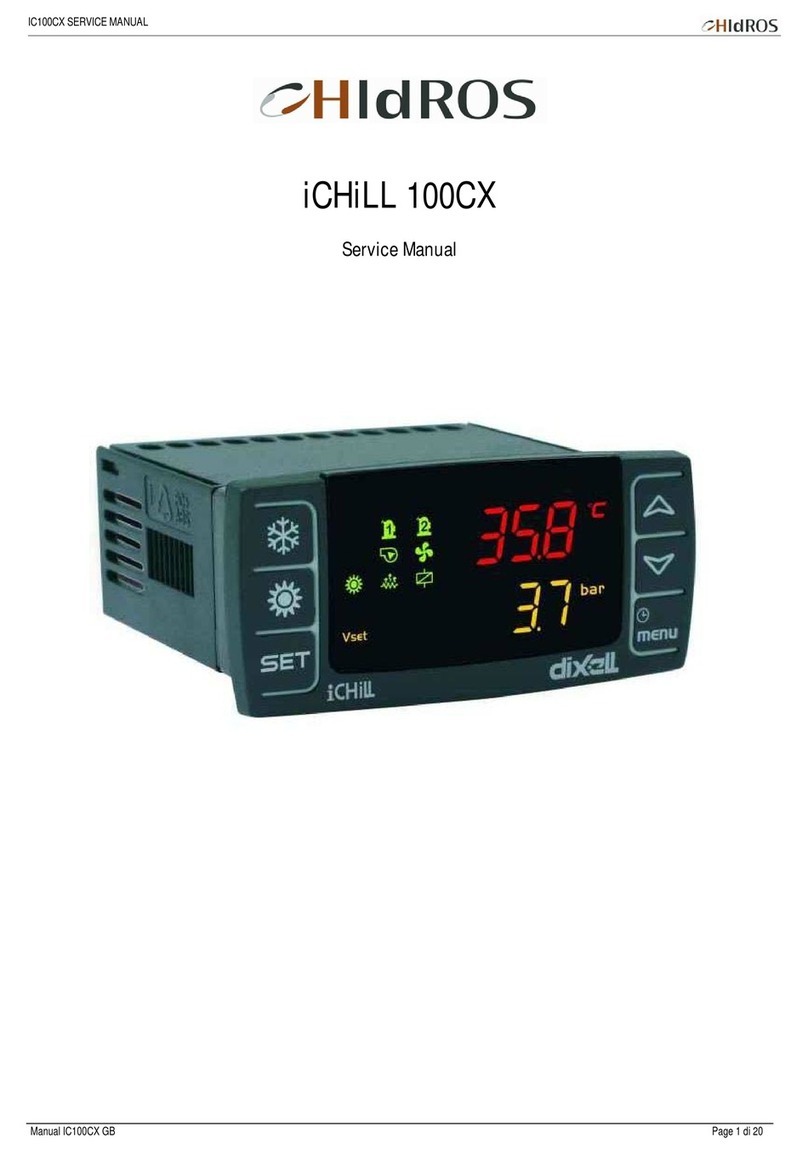
HIdRos
HIdRos iCHiLL 100CX User manual
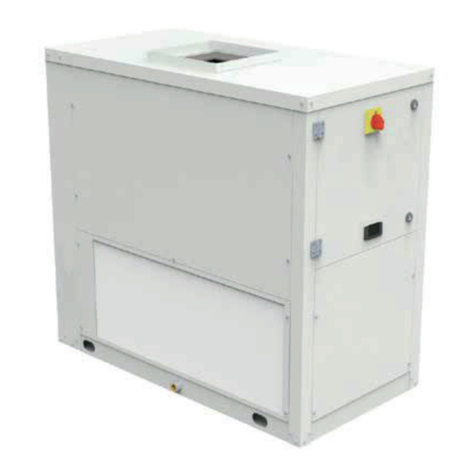
HIdRos
HIdRos HDA Series User manual
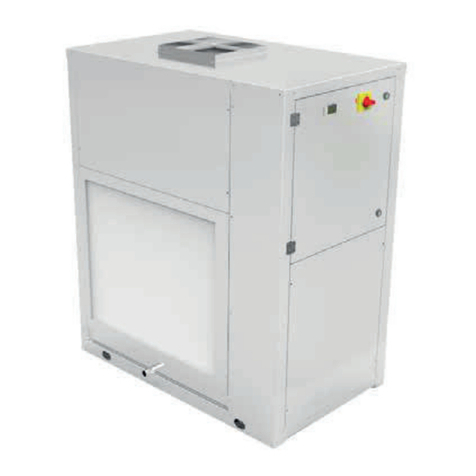
HIdRos
HIdRos SMA Series User manual
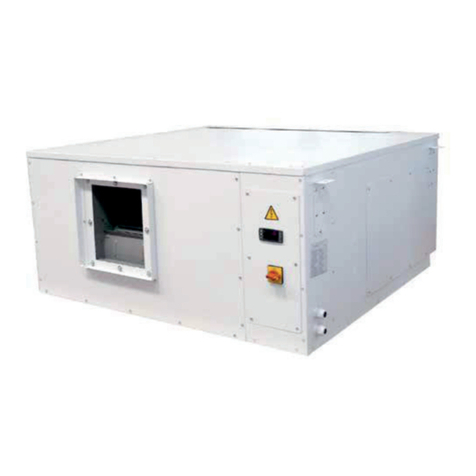
HIdRos
HIdRos HHA Series User manual

HIdRos
HIdRos SHA Series User manual
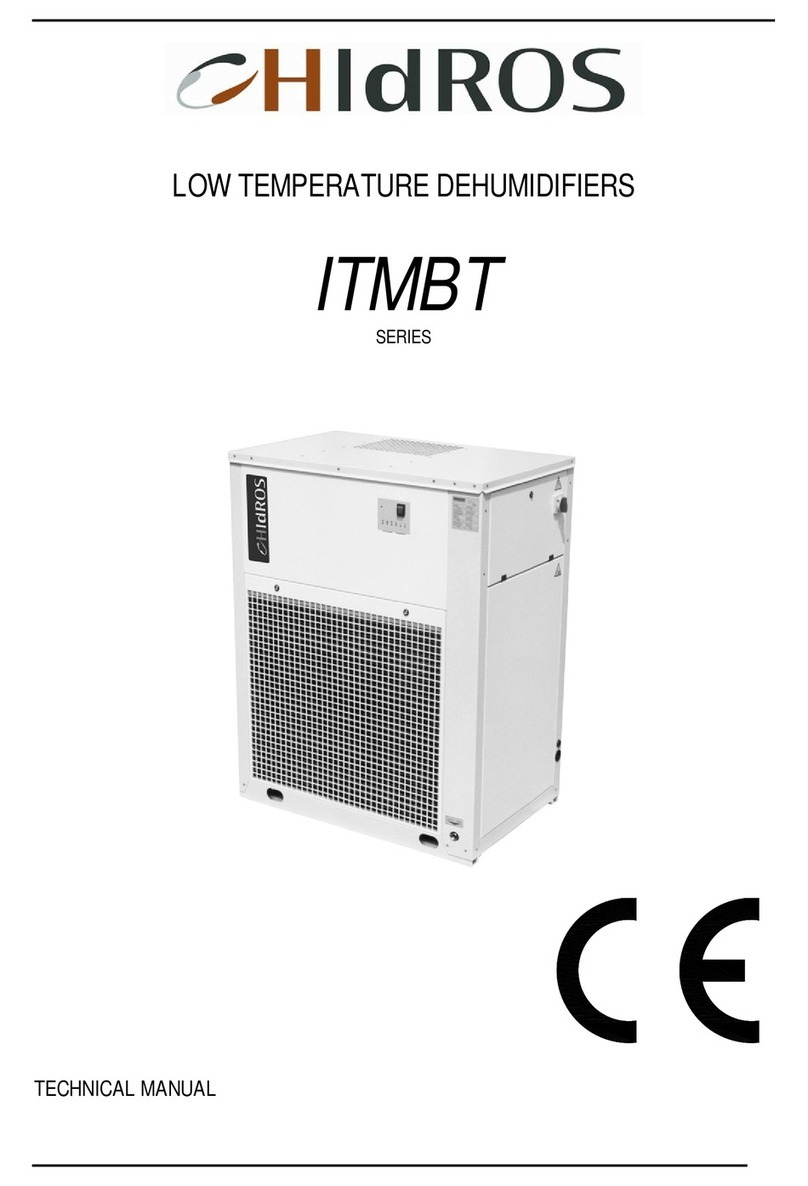
HIdRos
HIdRos ITMBT Series User manual
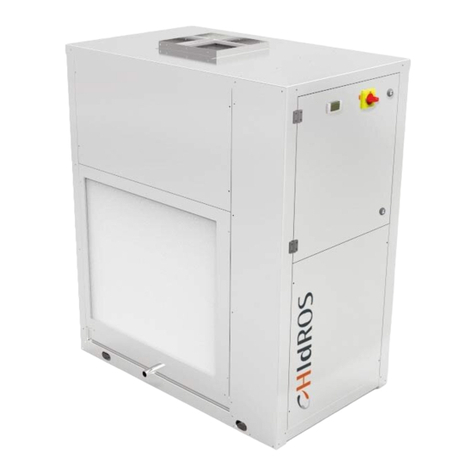
HIdRos
HIdRos HMA/Z Series User manual
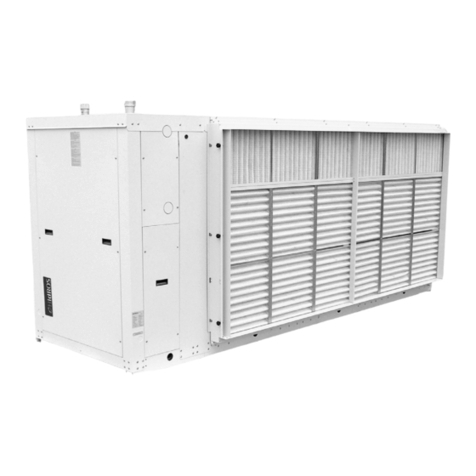
HIdRos
HIdRos SRH Series User manual

HIdRos
HIdRos SHH Series User manual
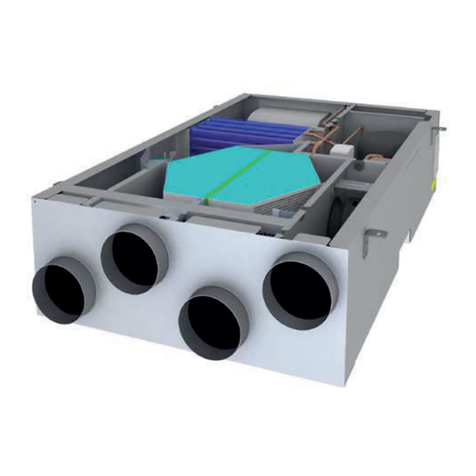
HIdRos
HIdRos GHE Series User manual



